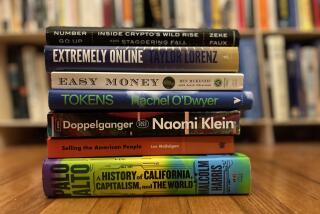‘What Stays in Vegas’ shines a light on the value of consumer data

- Share via
Books with sexy titles and decidedly unsexy topics — like, say, data — have a tendency to disappoint. But “What Stays in Vegas” is an engrossing, story-packed takedown of the data industry.
It begins, far from America’s gambling capital, in then-communist East Germany. The author, Adam Tanner, now a fellow at Harvard’s Institute for Quantitative Social Science, was a travel writer in the late 1980s taking notes on Dresden.
What he did not realize at the time was that the Stasi secret police in East Germany were busy taking notes on him — 50 pages in all — which he found when the files were opened after reunification.
The Stasi knew where he had stopped to consult a map, to whom he asked questions and when he looked in on a hotel.
Today, Tanner says : “Thanks to meticulous data gathering from both public documents and commercial records, companies … know far more about typical consumers than the feared East German secret police recorded about me.”
Shining a light on how businesses outside the tech sector have become data addicts, Tanner focuses on Las Vegas casinos, which spotted the value in data decades ago.
He was given access to Caesars Entertainment, one of the world’s largest casino operators. When Chief Executive Gary Loveman joined in the late 1990s, the former Harvard Business School professor bet the company’s future on harvesting personal data from its loyalty scheme.
Rather than wooing the “whales” who spent the most, the company would use the data to decide which freebies were worth giving away to lure in mid-level spenders who came back often — a strategy credited with helping the business grow.
The real revelations come when the author examines the data brokers’ “Cheez Whiz.” Like the maker of a popular processed dairy spread, Tanner writes, data brokers blend ingredients from a variety of sources, such as public records, marketing lists and commercial records.
With that, they create a detailed picture of your identity — and you will never quite be able to pin down the origin of any component.
Marketers can rent lists of gay people who own boats, recently divorced African Americans and women who have bought sex toys. One data broker sends people surveys on subjects such as constipation and cancer to gather data it can then sell to specialist marketers.
Another lures people to look up friends and family by suggesting that failing to check out their own files — or those of online dates — is dangerous. It even tells children to “background check your folks.”
The Big Data rush has gone into overdrive since the global economic crisis as marketers from different industries have sought new methods to grab the limited consumer spending available.
Tanner argues that while users have, in theory, given permission for much of this information to be made public in bits and pieces, increasingly industrial-scale aggregation often feels like an invasion of privacy.
Privacy policies are so long and obtuse (one study Tanner quotes found that it would take people more than a month, working full-time, to read all the privacy statements they come across in a year), people are unwittingly littering their data all over the Internet.
Anyway, marketers can determine what we are like from the people we are connected to online. And as the data brokers’ lists are usually private, there is no way to check that the compilers have got their facts right.
Published by PublicAffairs, the new book “What Stays in Vegas: The World of Personal Data — Lifeblood of Big Business — and the End of Privacy as We Know It” is mainly a well-reported tale of how we ended up here.
Tanner skates over the data-obsessive social networks (as he acknowledges). But he does look at the avenues that leisure and retail industries may yet pursue, including the potential to use data from mobile devices and photo recognition technology to track individuals.
He does not provide any sweeping solutions that will stop mass privacy invasion. But he offers modest, sensible-sounding measures, such as creating easier to understand privacy policies modeled on nutrition guidelines on food packaging; allowing people access to their own data profiles; and educating children about what they need to keep private.
Perhaps most important, given that it is such a murky subject, “What Stays in Vegas” offers a narrative that transforms Big Data from spreadsheet-dull to a racy read that people will pay attention to.
Hannah Kuchler is a San Francisco-based correspondent for the Financial Times of London, in which this review first appeared.
More to Read
Inside the business of entertainment
The Wide Shot brings you news, analysis and insights on everything from streaming wars to production — and what it all means for the future.
You may occasionally receive promotional content from the Los Angeles Times.










